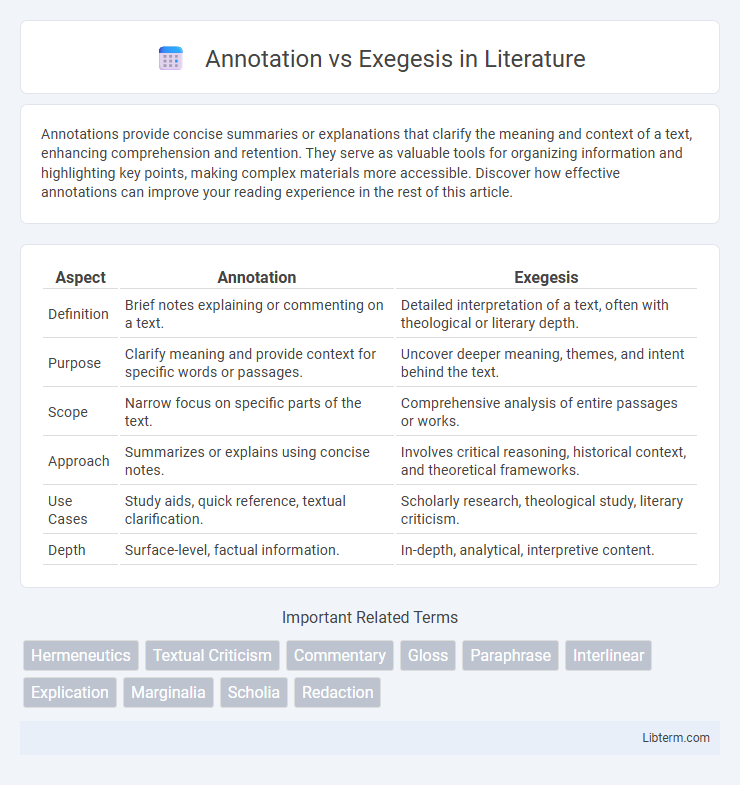Annotations provide concise summaries or explanations that clarify the meaning and context of a text, enhancing comprehension and retention. They serve as valuable tools for organizing information and highlighting key points, making complex materials more accessible. Discover how effective annotations can improve your reading experience in the rest of this article.
Table of Comparison
| Aspect | Annotation | Exegesis |
|---|---|---|
| Definition | Brief notes explaining or commenting on a text. | Detailed interpretation of a text, often with theological or literary depth. |
| Purpose | Clarify meaning and provide context for specific words or passages. | Uncover deeper meaning, themes, and intent behind the text. |
| Scope | Narrow focus on specific parts of the text. | Comprehensive analysis of entire passages or works. |
| Approach | Summarizes or explains using concise notes. | Involves critical reasoning, historical context, and theoretical frameworks. |
| Use Cases | Study aids, quick reference, textual clarification. | Scholarly research, theological study, literary criticism. |
| Depth | Surface-level, factual information. | In-depth, analytical, interpretive content. |
Introduction to Annotation and Exegesis
Annotation involves concise notes or comments added to a text for clarification, explanation, or critique, often focusing on specific words or passages. Exegesis is the critical interpretation and detailed analysis of a text, especially religious or literary works, aiming to uncover deeper meanings and contextual relevance. Both practices enhance understanding but differ in scope and depth, with annotation providing brief explanations and exegesis offering comprehensive interpretation.
Defining Annotation
Annotation involves adding concise explanatory notes or comments directly to a text to clarify meaning, highlight important details, or provide context. It serves as a tool for readers to interact with the text by marking key phrases, offering definitions, or making brief observations. Unlike exegesis, which requires comprehensive interpretation and critical analysis of a passage, annotation remains more focused on immediate comprehension and textual engagement.
Understanding Exegesis
Exegesis involves a critical and systematic interpretation of texts, primarily sacred scriptures, aiming to unveil original meanings in historical and cultural contexts. Unlike annotation, which offers brief explanatory notes or comments, exegesis employs linguistic, theological, and literary analysis to provide deeper insight into the text's intent and message. Scholars utilize exegesis to bridge ancient writings and contemporary understanding, ensuring interpretations remain faithful to the source material.
Key Differences between Annotation and Exegesis
Annotation involves brief, concise notes highlighting key observations or interpretations directly related to specific passages within a text, enhancing comprehension without extensive analysis. Exegesis entails a thorough, systematic examination of a text, aiming to uncover deeper meaning through historical context, linguistic detail, and theological insights. The primary difference lies in annotation's succinct, surface-level commentary versus exegesis's in-depth, scholarly interpretation intended for comprehensive understanding.
Goals and Objectives of Annotation
Annotation aims to clarify and explain specific parts of a text, enhancing comprehension and providing concise, targeted notes that highlight important details or contextual information. Its objective is to facilitate quick understanding and reference, supporting readers in grasping complex or dense content effectively. Unlike exegesis, which involves detailed critical interpretation and theological analysis, annotation focuses on immediate textual clarification and practical insight.
Purposes and Methods of Exegesis
Exegesis aims to uncover the original meaning of a biblical text through detailed analysis, focusing on historical context, linguistic nuances, and author intent. Methods of exegesis include textual criticism, grammatical analysis, and exploring cultural background to interpret scripture accurately. Unlike annotation, which provides brief explanatory notes or comments, exegesis involves systematic, scholarly investigation to reveal deeper theological and literary insights.
Practical Examples of Annotation
Annotation involves adding concise notes or comments directly to a text to clarify meaning, highlight key themes, or explain difficult vocabulary, such as underlining a metaphor in a poem and writing its interpretation in the margin. Exegesis, by contrast, entails a detailed and critical analysis of a text's historical context, linguistic elements, and theological implications, often resulting in an extended commentary or scholarly essay. Practical examples of annotation include marking up legal documents with brief explanations of statutes, highlighting key arguments in academic articles for quick review, or noting reactions and questions in literary texts to enhance comprehension.
Illustrative Cases of Exegesis
Exegesis involves detailed interpretation of texts, uncovering deeper meanings often through historical, cultural, and linguistic analysis, as seen in biblical exegesis where scholars dissect scripture to understand original intent and context. Annotation typically provides brief explanations or notes to clarify specific words or passages without extensive interpretation. Illustrative cases of exegesis include exploring the parables in the New Testament, where interpretation reveals theological themes and cultural symbolism that mere annotation cannot convey.
Choosing the Right Approach: Annotation or Exegesis
Choosing between annotation and exegesis depends on the depth of textual analysis required; annotation offers concise, context-specific notes ideal for quick reference and clarification, while exegesis provides a comprehensive, detailed interpretation emphasizing historical, cultural, and linguistic insights. Scholars select annotation when needing to highlight thematic elements or linguistic features briefly, whereas exegesis suits in-depth study aiming to uncover layered meanings and theological implications. The decision hinges on the research purpose, audience, and desired level of scholarly engagement with the text.
Conclusion: Integrating Annotation and Exegesis
Integrating annotation and exegesis enhances biblical study by combining detailed textual notes with in-depth interpretative analysis, allowing for a comprehensive understanding of scriptures. Annotation provides concise explanations and context, while exegesis delves into theological and historical meanings, creating a balanced approach. This synergy supports scholars and readers in accurately interpreting biblical texts with both precision and depth.
Annotation Infographic

 libterm.com
libterm.com